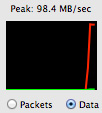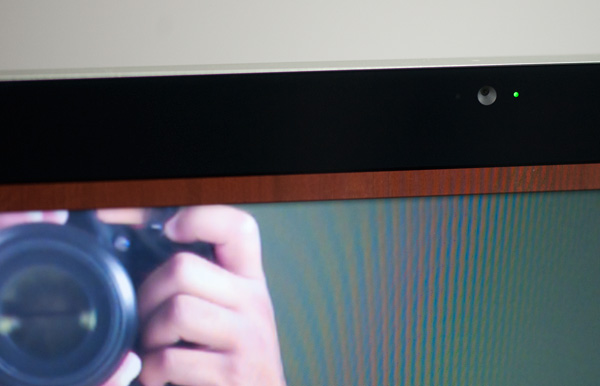The Apple Thunderbolt Display Review
by Anand Lal Shimpi on September 23, 2011 2:56 AM EST- Posted in
- Displays
- Mac
- Apple
- Thunderbolt
- Thunderbolt Display
Testing the Pieces
Before we get to the display and Thunderbolt specific testing I wanted to confirm that the individual controllers in the Thunderbolt Display were just as capable as those in the Mac it was connected to. For the most part, they are.
Following in Brian Klug's footsteps, I created two RAM disks - one on a MacBook Air and one on a MacBook Pro. I connected both systems to my local GigE network and copied giant files between them. I measured over 780Mbps going from the MacBook Air to the MacBook Pro, and 832Mbps in the other direction (images below). That's about as good as it's going to get.
 |
 |
Next I tested performance over FireWire 800 and USB 2.0. For FireWire 800 I used a Western Digital My Book Studio Edition II configured in RAID-1 and measured peak read speed from the device. For USB testing I turned to a Corsair Flash Voyager 3.0 (USB stick) and a SF-2281 SSD connected to a SATA-to-USB bridge. In both of the USB tests I measured write speed to the USB 2.0 devices. Apple appears to have chosen its FireWire controller well as performance was only off by 2MB/s compared to the FW800 port on the 15-inch MacBook Pro. USB 2.0 performance wasn't nearly as good however, I maxed out at 16.4MB/s and saw typical rates closer to 15MB/s:
| Transfer Rate Comparison | |||||
| FireWire 800 | USB 2.0 (stick) | USB 2.0 (SSD) | |||
| Apple Thunderbolt Display | 70.0 MB/s | 14.1 MB/s | 16.4 MB/s | ||
| Apple 15-inch MacBook Pro (2011) | 72.0 MB/s | 21.2 MB/s | 32.2 MB/s | ||
Both the audio controller and FaceTime HD cameras interface via the Thunderbolt Display's internal USB controller. It's likely that one of those devices is forcing the controller to negotiate at a lower speed and thus ultimately limit peak USB 2.0 performance through the display. Note the gap in performance is much smaller if you're looking at transfers to a USB stick vs. an SSD. I happen to have a lot of SSDs around so I tend to use them as glorified USB sticks, I suspect the majority of users won't notice much of a difference due to the lower overall performance of standard USB sticks.
FaceTime HD Camera
Although Photo Booth in Lion captures at 1080 x 720, using iSightcapture I was able to confirm that the sensor in the Thunderbolt Display appears to be able to capture 1280 x 720 natively. Quality is what we'd come to expect from the current generation of FaceTime HD cameras.
I tested the camera both in Photo Booth and in a FaceTime chat with our own Brian Klug. The experience worked fine in both cases.

FaceTime seems to have issues when one party is in a noisy environment but that doesn't appear to have anything to do with the Thunderbolt Display hardware as I duplicated the issue on a MacBook Air as well. If you're curious, the problem I'm talking about occurs when the party in a quiet environment is trying to talk to the person with a lot of background noise. The quiet party will hear audio just fine but the noisy party will get a lot of broken up audio from the other side. It seems like FaceTime is trying to do some active noise cancelation that ends up doing more harm than good. I confirmed it's a FaceTime software problem by calling Brian via Skype without any issues.











275 Comments
View All Comments
Boopop - Friday, September 23, 2011 - link
OK, so my Dell 2408WFP isn't as big, but in most if not all the tests it outperforms this new monitor. If I was a graphic designer (which I'm not!), even if I had a MBA I reckon I'd stick with a higher quality monitor, and put up with the extra cables.On the other hand, if I was the average Joe Bloggs with a MBA, this makes a great monitor for that specific laptop. I like where Apple are going with this, it's just a shame about the lack of many USB ports, and the average screen quality.
IceDread - Friday, September 23, 2011 - link
Normally when you test a display you also test the input lag which I find very important. I could not find info about input lag in this review.tipoo - Friday, September 23, 2011 - link
Not really as important to the target demographic, I think. Most people who get these will be using them for professional tools, so things like colour accuracy are more important than reaction time. If someone is buying one of these and a mac to game on, they've made a pretty bad error, lol.jecs - Friday, September 23, 2011 - link
You have the general idea right.For professionals not demanding the highest color accuracy for print or for broadcast production yes, the Apple monitor is a good choice. That is professionals who work on content creation like internet video, corporate videos or print material among others.
Serious print houses, photographers or broadcast professionals will choose high end specialized monitors in the range of $3000+, not in the sub $1000.
JasperJanssen - Saturday, September 24, 2011 - link
But they will generally only choose that type of monitor for *one* display, where the guy sits who does final colour correction on the output -- not for all the content creation people. (fair enough, if you're large enough that's multiple people, but it's never going to be the majority of your staff).Anand Lal Shimpi - Friday, September 23, 2011 - link
We normally test input lag by driving a CRT in parallel with the display being evaluated. I didn't have a good way of doing that with a Thunderbolt display unfortunately :-/Take care,
Anand
JasperJanssen - Saturday, September 24, 2011 - link
Well, keep it on the list for when the Mac pro comes out, which will hopefully have a videocard with multiple thunderbolt outputs :)Come to think of it -- new iMac with dual thunderbolt out and one of them through a VGA dongle? Hmno. Those are active dongles, which mess up results.
Two PCs, using NTP or something similar to sync up their internal clocks maximally, and one driving a VGA CRT with the other driving the thunderbolt display, each displaying very precisely the current system time in a large font, plus the usual fast shutter speed photography. Your accuracy would depend on the NTP-or-similar protocol. I wonder if you can get close enough with that, over a crossover Gigabit ethernet kept free of other traffic.
If you do get something like that running, you can also compare input lag between:
- Display port driving Displayport display
- Thunderbolt port driving Displayport display
- Thunderbolt port driving Thunderbolt display
-Thunderbolt port driving thunderbolt display switched through another TB device or display (add to the chain as possible)
And even whether displayport mac versus thunderbolt macs are different in this respect when running over the various dongles.
I would expect a Thunderbolt port running in Displayport mode to be very slightly slower than a real displayport, would be interesting to see if that is the case, and how it compares to a TB port in TB mode, and whether other devices on the chain affect it.
JasperJanssen - Saturday, September 24, 2011 - link
"NTP v4 with kernel mods to support it, is capable of much better than 1ms accuracy, possibly as good as 1ns. According to his article, NTP v3 is accurate to 1-2ms in a LAN and 10s of ms in WAN nets. "Well, since what you need is ms range, I guess this could actually work.
sheh - Tuesday, September 27, 2011 - link
I was curious about that too. Regardless of who the target audience of the monitor is, it's a new technology so I'm curious about its performance vs. DP/DVI/VGA. But could be difficult to tell apart from the panel's logic own latency, at least until there are more TB displays.MrJim - Friday, September 23, 2011 - link
The Youtube-video in this article, http://www.youtube.com/watch?v=LtAgkIE42jc&fea... , is private. Hard to see then :)